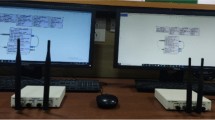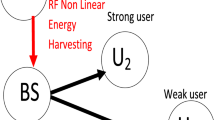Abstract
Cognitive Radio (CR) has been proposed as a system-level means to improve the spectrum utilization efficiency. The most significant premise for CR networks is to avoid harmful interference to the licensed users. Therefore, it is very important to estimate the potential interference introduced by the deployment of CR networks so that CR networks can be coexistence with Licensed User (LU) networks by designing proper system parameters. In this paper, two statistical models of potential interference due to CR networks are developed based on transmitter and receiver oriented spectrum sensing schemes, respectively. The approximate probability distributions of aggregate interference introduced by CR networks are then derived with respect to the obtained models. With the help of these probability distributions, a method is further presented to get the critical system parameter, i.e., sensing distance and user density of the CR networks, so that the introduced interference can be controlled to predefined level. Numerical results validate the proposed interference estimation method and confirm the effectiveness of interference distribution based system parameter design.
Similar content being viewed by others
References
FCC. ET Docket No 03-222 Notice of proposed rule making and order. December 2003.
J. Mitola III and G. O. Maguire. Cognitive radio: making software radio more personal. IEEE Personal Communications, 6(1999)4, 13–18.
I. F. Akyildiz, W. Y. Lee, M. Vuran, and S. Mohanty. Next generation/dynamic spectrum access/cognitive radio wireless networks: A survey. Computer Networks, 50(2006)13, 2127–2159.
T. A. Weiss and F. K. Jondral. Spectrum pooling: an innovative strategy for the enhancement of spectrum efficiency. IEEE Communications Magazine, 42(2004) 3, S8–14.
Ghasemi and E. S. Sousa. Spectrum sensing in cognitive radio networks: requirements, challenges and design trade-offs. IEEE Communications Magazine, 46(2008)4, 32–39.
Y. Zeng, Y.-C. Liang, A. T. Hoang, et al.. A review on spectrum sensing for cognitive radio: challenges and solutions. EURASIP Journal on Advances in Signal Processing: Special Issue on Advanced Signal Processing for Cognitive Radio Networks, 2010(2010), 1–15.
Qing Zhao and Brain M. Sadler. A survey of dynamic spectrum access. Signal Processing, 24(2007)3, 79–89.
T. Yucek and H. Arslan. A survey of spectrum sensing algorithms for cognitive radio applications. IEEE Communications Survey & Tutorials, 11(2009)1, 116–130.
IEEE P802.22/ Draft v2.0. Draft Standard for Wireless Regional Area Networks Part 22: Cognitive Wireless RAN Medium Access Control (MAC) and Physical Layer (PHY) specifications: Policies and procedures for operation in the TV Bands. May 2009.
Ghasemi and E. S. Sousa. Interference aggregation in spectrum-sensing cognitive wireless networks. Journal of Selected Topics in Signal Processing, 2(2008)1, 41–46.
FCC. ET Docket-237, 03-289 Notice of Inquiry and Notice of Proposed Rulemaking. 2003.
Amir Ghasemi. Statistical characterization of interference in cognitive radio networks. Personal, Indoor and Mobile Radio Communications (PIMRC’2008), Cannes, September 15–18, 2008, 1–6.
F. A. Andrews. Two 50% probabilities. The Journal of the Acoustical Society of America, 57(1975)1, 245–248.
J. F. C. Kingman. Poisson Processes. New York, Oxford University Press, 1993.
Jan Grandell. Mixed Possion Processes. New York, Chapman & Hall, 1997.
Author information
Authors and Affiliations
Corresponding author
Additional information
Supported by the High-tech Research and Development Program (863 Program) of China (No. 2009AA011801), the National Basic Research Program (973 Program) of China (No. 2009CB320405), the Foundation Project of National Key Laboratory of Science and Technology on Communications (No. 9140C0202061004), and the Fundamental Research Funds for the Central Universities (No. ZYGX2009X002).
Communication author: Chen Ronghao, born in 1986, male, Master.
About this article
Cite this article
Chen, R., Chen, W., Wang, J. et al. Interference estimation and its applications in cognitive radio networks. J. Electron.(China) 27, 630–638 (2010). https://doi.org/10.1007/s11767-011-0503-2
Received:
Revised:
Published:
Issue Date:
DOI: https://doi.org/10.1007/s11767-011-0503-2




